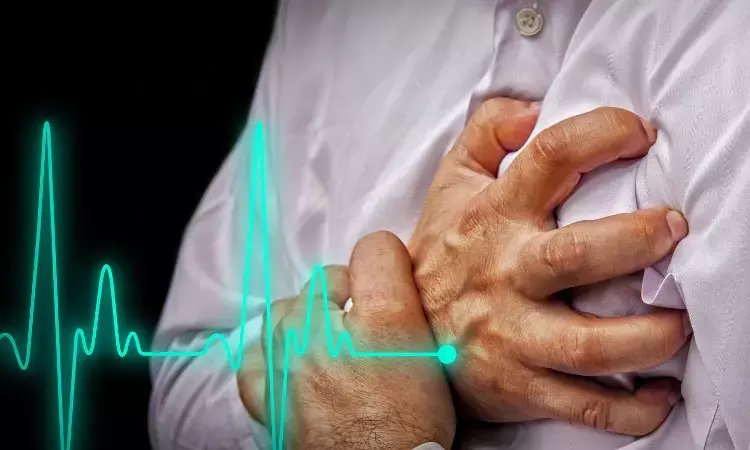- Home
- Medical news & Guidelines
- Anesthesiology
- Cardiology and CTVS
- Critical Care
- Dentistry
- Dermatology
- Diabetes and Endocrinology
- ENT
- Gastroenterology
- Medicine
- Nephrology
- Neurology
- Obstretics-Gynaecology
- Oncology
- Ophthalmology
- Orthopaedics
- Pediatrics-Neonatology
- Psychiatry
- Pulmonology
- Radiology
- Surgery
- Urology
- Laboratory Medicine
- Diet
- Nursing
- Paramedical
- Physiotherapy
- Health news
- Fact Check
- Bone Health Fact Check
- Brain Health Fact Check
- Cancer Related Fact Check
- Child Care Fact Check
- Dental and oral health fact check
- Diabetes and metabolic health fact check
- Diet and Nutrition Fact Check
- Eye and ENT Care Fact Check
- Fitness fact check
- Gut health fact check
- Heart health fact check
- Kidney health fact check
- Medical education fact check
- Men's health fact check
- Respiratory fact check
- Skin and hair care fact check
- Vaccine and Immunization fact check
- Women's health fact check
- AYUSH
- State News
- Andaman and Nicobar Islands
- Andhra Pradesh
- Arunachal Pradesh
- Assam
- Bihar
- Chandigarh
- Chattisgarh
- Dadra and Nagar Haveli
- Daman and Diu
- Delhi
- Goa
- Gujarat
- Haryana
- Himachal Pradesh
- Jammu & Kashmir
- Jharkhand
- Karnataka
- Kerala
- Ladakh
- Lakshadweep
- Madhya Pradesh
- Maharashtra
- Manipur
- Meghalaya
- Mizoram
- Nagaland
- Odisha
- Puducherry
- Punjab
- Rajasthan
- Sikkim
- Tamil Nadu
- Telangana
- Tripura
- Uttar Pradesh
- Uttrakhand
- West Bengal
- Medical Education
- Industry
Implant interatrial shunt associated with improved quality of life and symptoms

According to series of feasibility studies, creation of a left-to-right shunt in the interatrial septum to offload failing hearts improved quality of life and symptoms.
Results from early clinical evaluation of the Alleviant System to treat heart failure patients with preserved and reduced ejection fraction (HFpEF and HFrEF) was presented today as late-breaking clinical research at the Society for Cardiovascular Angiography & Interventions (SCAI) 2022 Scientific Sessions. This multi-center evaluation across three trial programs (ALLEVIATE-HF-1, HF-2 and HFrEF) demonstrated procedural safety and feasibility with a promising efficacy signal through six months.
Impacting more than 26 million people worldwide, heart failure occurs when the heart muscle is unable to pump effectively enough to meet the body's need for blood and oxygen (NLM). Currently guidelines recommend medical therapy for heart failure patients with HFpEF and HFrEF, however some remain symptomatic despite optimal medical therapy.
The Alleviant System is a transcatheter technology intended to reduce pressure within the left atrium through the creation of a therapeutic interatrial shunt without a permanent cardiac implant or open-heart surgery.
Patients aged ≥ 40 years, New York Heart Association (NYHA) class II, III or ambulatory IV with elevated peak exercise PCWP were included in the study. Baseline screening included echocardiography, exercise right heart catheterization, KCCQ and 6MWT.
Following a transseptal puncture, the Alleviant device was inserted through the femoral vein (located near the groin), advanced to the heart and supplied with a short pulse of radiofrequency energy in order to remove a segment of the interatrial septum-a thin wall of tissue that separates the right and left atria of the heart. Procedures were performed under fluoroscopic and echocardiographic guidance.
To date, 31 patients have been followed through three months and 15 patients through six months. Mean peak exercise PCWP decreased from baseline to one month across all studies. A significant increase in KCCQ overall summary score was observed at six months in the HF-1 study and at three months in the HF-2 and HFrEF studies.
Echocardiography confirmed all shunts evaulated remained patent at one, three and six months; 10 patients have additionally completed one-year follow-up with confirmed shunt patency. The investigators and research team will continue to evaluate the Alleviant System as they collect ongoing follow-up data.
"Unfortunately, we know that this group of heart failure patients currently has limited treatment options," said Colin M. Barker, M.D., FSCAI,, Director of the Cardiac Cath Lab, Vanderbilt University Medical Center in Nashville, Tenn. and lead author of the study. "This early data is promising and shows that we are headed down the right path in developing a new safe and effective approach, without the burden of an implant, to help address the unique needs of this large and underserved patient population."
Reference:
Barker CM, et al. Featured Clinical Research: Part 2. Presented at: Society for Cardiovascular Angiography and Interventions Scientific Sessions; May 19-22, 2022; Atlanta.
Dr Kamal Kant Kohli-MBBS, DTCD- a chest specialist with more than 30 years of practice and a flair for writing clinical articles, Dr Kamal Kant Kohli joined Medical Dialogues as a Chief Editor of Medical News. Besides writing articles, as an editor, he proofreads and verifies all the medical content published on Medical Dialogues including those coming from journals, studies,medical conferences,guidelines etc. Email: drkohli@medicaldialogues.in. Contact no. 011-43720751


